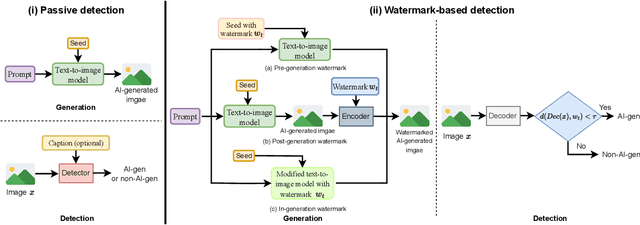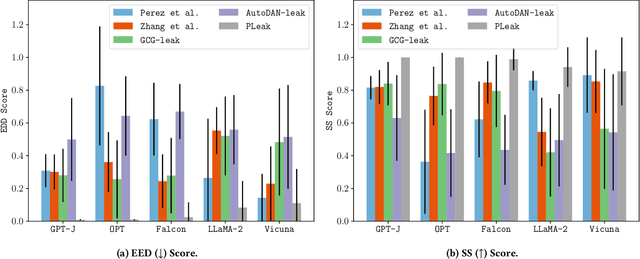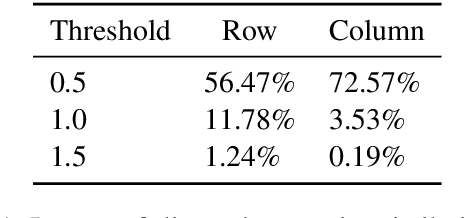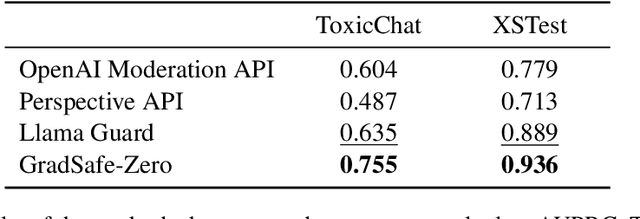Neil Gong
Mitigating Watermark Stealing Attacks in Generative Models via Multi-Key Watermarking
Jul 10, 2025Abstract:Watermarking offers a promising solution for GenAI providers to establish the provenance of their generated content. A watermark is a hidden signal embedded in the generated content, whose presence can later be verified using a secret watermarking key. A threat to GenAI providers are \emph{watermark stealing} attacks, where users forge a watermark into content that was \emph{not} generated by the provider's models without access to the secret key, e.g., to falsely accuse the provider. Stealing attacks collect \emph{harmless} watermarked samples from the provider's model and aim to maximize the expected success rate of generating \emph{harmful} watermarked samples. Our work focuses on mitigating stealing attacks while treating the underlying watermark as a black-box. Our contributions are: (i) Proposing a multi-key extension to mitigate stealing attacks that can be applied post-hoc to any watermarking method across any modality. (ii) We provide theoretical guarantees and demonstrate empirically that our method makes forging substantially less effective across multiple datasets, and (iii) we formally define the threat of watermark forging as the task of generating harmful, watermarked content and model this threat via security games.
GraphRAG under Fire
Jan 23, 2025Abstract:GraphRAG advances retrieval-augmented generation (RAG) by structuring external knowledge as multi-scale knowledge graphs, enabling language models to integrate both broad context and granular details in their reasoning. While GraphRAG has demonstrated success across domains, its security implications remain largely unexplored. To bridge this gap, this work examines GraphRAG's vulnerability to poisoning attacks, uncovering an intriguing security paradox: compared to conventional RAG, GraphRAG's graph-based indexing and retrieval enhance resilience against simple poisoning attacks; meanwhile, the same features also create new attack surfaces. We present GRAGPoison, a novel attack that exploits shared relations in the knowledge graph to craft poisoning text capable of compromising multiple queries simultaneously. GRAGPoison employs three key strategies: i) relation injection to introduce false knowledge, ii) relation enhancement to amplify poisoning influence, and iii) narrative generation to embed malicious content within coherent text. Empirical evaluation across diverse datasets and models shows that GRAGPoison substantially outperforms existing attacks in terms of effectiveness (up to 98% success rate) and scalability (using less than 68% poisoning text). We also explore potential defensive measures and their limitations, identifying promising directions for future research.
GRID: Protecting Training Graph from Link Stealing Attacks on GNN Models
Jan 19, 2025



Abstract:Graph neural networks (GNNs) have exhibited superior performance in various classification tasks on graph-structured data. However, they encounter the potential vulnerability from the link stealing attacks, which can infer the presence of a link between two nodes via measuring the similarity of its incident nodes' prediction vectors produced by a GNN model. Such attacks pose severe security and privacy threats to the training graph used in GNN models. In this work, we propose a novel solution, called Graph Link Disguise (GRID), to defend against link stealing attacks with the formal guarantee of GNN model utility for retaining prediction accuracy. The key idea of GRID is to add carefully crafted noises to the nodes' prediction vectors for disguising adjacent nodes as n-hop indirect neighboring nodes. We take into account the graph topology and select only a subset of nodes (called core nodes) covering all links for adding noises, which can avert the noises offset and have the further advantages of reducing both the distortion loss and the computation cost. Our crafted noises can ensure 1) the noisy prediction vectors of any two adjacent nodes have their similarity level like that of two non-adjacent nodes and 2) the model prediction is unchanged to ensure zero utility loss. Extensive experiments on five datasets are conducted to show the effectiveness of our proposed GRID solution against different representative link-stealing attacks under transductive settings and inductive settings respectively, as well as two influence-based attacks. Meanwhile, it achieves a much better privacy-utility trade-off than existing methods when extended to GNNs.
AI-generated Image Detection: Passive or Watermark?
Nov 20, 2024



Abstract:While text-to-image models offer numerous benefits, they also pose significant societal risks. Detecting AI-generated images is crucial for mitigating these risks. Detection methods can be broadly categorized into passive and watermark-based approaches: passive detectors rely on artifacts present in AI-generated images, whereas watermark-based detectors proactively embed watermarks into such images. A key question is which type of detector performs better in terms of effectiveness, robustness, and efficiency. However, the current literature lacks a comprehensive understanding of this issue. In this work, we aim to bridge that gap by developing ImageDetectBench, the first comprehensive benchmark to compare the effectiveness, robustness, and efficiency of passive and watermark-based detectors. Our benchmark includes four datasets, each containing a mix of AI-generated and non-AI-generated images. We evaluate five passive detectors and four watermark-based detectors against eight types of common perturbations and three types of adversarial perturbations. Our benchmark results reveal several interesting findings. For instance, watermark-based detectors consistently outperform passive detectors, both in the presence and absence of perturbations. Based on these insights, we provide recommendations for detecting AI-generated images, e.g., when both types of detectors are applicable, watermark-based detectors should be the preferred choice.
Byzantine-Robust Decentralized Federated Learning
Jun 18, 2024



Abstract:Federated learning (FL) enables multiple clients to collaboratively train machine learning models without revealing their private training data. In conventional FL, the system follows the server-assisted architecture (server-assisted FL), where the training process is coordinated by a central server. However, the server-assisted FL framework suffers from poor scalability due to a communication bottleneck at the server, and trust dependency issues. To address challenges, decentralized federated learning (DFL) architecture has been proposed to allow clients to train models collaboratively in a serverless and peer-to-peer manner. However, due to its fully decentralized nature, DFL is highly vulnerable to poisoning attacks, where malicious clients could manipulate the system by sending carefully-crafted local models to their neighboring clients. To date, only a limited number of Byzantine-robust DFL methods have been proposed, most of which are either communication-inefficient or remain vulnerable to advanced poisoning attacks. In this paper, we propose a new algorithm called BALANCE (Byzantine-robust averaging through local similarity in decentralization) to defend against poisoning attacks in DFL. In BALANCE, each client leverages its own local model as a similarity reference to determine if the received model is malicious or benign. We establish the theoretical convergence guarantee for BALANCE under poisoning attacks in both strongly convex and non-convex settings. Furthermore, the convergence rate of BALANCE under poisoning attacks matches those of the state-of-the-art counterparts in Byzantine-free settings. Extensive experiments also demonstrate that BALANCE outperforms existing DFL methods and effectively defends against poisoning attacks.
PLeak: Prompt Leaking Attacks against Large Language Model Applications
May 14, 2024



Abstract:Large Language Models (LLMs) enable a new ecosystem with many downstream applications, called LLM applications, with different natural language processing tasks. The functionality and performance of an LLM application highly depend on its system prompt, which instructs the backend LLM on what task to perform. Therefore, an LLM application developer often keeps a system prompt confidential to protect its intellectual property. As a result, a natural attack, called prompt leaking, is to steal the system prompt from an LLM application, which compromises the developer's intellectual property. Existing prompt leaking attacks primarily rely on manually crafted queries, and thus achieve limited effectiveness. In this paper, we design a novel, closed-box prompt leaking attack framework, called PLeak, to optimize an adversarial query such that when the attacker sends it to a target LLM application, its response reveals its own system prompt. We formulate finding such an adversarial query as an optimization problem and solve it with a gradient-based method approximately. Our key idea is to break down the optimization goal by optimizing adversary queries for system prompts incrementally, i.e., starting from the first few tokens of each system prompt step by step until the entire length of the system prompt. We evaluate PLeak in both offline settings and for real-world LLM applications, e.g., those on Poe, a popular platform hosting such applications. Our results show that PLeak can effectively leak system prompts and significantly outperforms not only baselines that manually curate queries but also baselines with optimized queries that are modified and adapted from existing jailbreaking attacks. We responsibly reported the issues to Poe and are still waiting for their response. Our implementation is available at this repository: https://github.com/BHui97/PLeak.
Stable Signature is Unstable: Removing Image Watermark from Diffusion Models
May 12, 2024



Abstract:Watermark has been widely deployed by industry to detect AI-generated images. A recent watermarking framework called \emph{Stable Signature} (proposed by Meta) roots watermark into the parameters of a diffusion model's decoder such that its generated images are inherently watermarked. Stable Signature makes it possible to watermark images generated by \emph{open-source} diffusion models and was claimed to be robust against removal attacks. In this work, we propose a new attack to remove the watermark from a diffusion model by fine-tuning it. Our results show that our attack can effectively remove the watermark from a diffusion model such that its generated images are non-watermarked, while maintaining the visual quality of the generated images. Our results highlight that Stable Signature is not as stable as previously thought.
Concealing Backdoor Model Updates in Federated Learning by Trigger-Optimized Data Poisoning
May 10, 2024



Abstract:Federated Learning (FL) is a decentralized machine learning method that enables participants to collaboratively train a model without sharing their private data. Despite its privacy and scalability benefits, FL is susceptible to backdoor attacks, where adversaries poison the local training data of a subset of clients using a backdoor trigger, aiming to make the aggregated model produce malicious results when the same backdoor condition is met by an inference-time input. Existing backdoor attacks in FL suffer from common deficiencies: fixed trigger patterns and reliance on the assistance of model poisoning. State-of-the-art defenses based on Byzantine-robust aggregation exhibit a good defense performance on these attacks because of the significant divergence between malicious and benign model updates. To effectively conceal malicious model updates among benign ones, we propose DPOT, a backdoor attack strategy in FL that dynamically constructs backdoor objectives by optimizing a backdoor trigger, making backdoor data have minimal effect on model updates. We provide theoretical justifications for DPOT's attacking principle and display experimental results showing that DPOT, via only a data-poisoning attack, effectively undermines state-of-the-art defenses and outperforms existing backdoor attack techniques on various datasets.
A Transfer Attack to Image Watermarks
Mar 25, 2024



Abstract:Watermark has been widely deployed by industry to detect AI-generated images. The robustness of such watermark-based detector against evasion attacks in the white-box and black-box settings is well understood in the literature. However, the robustness in the no-box setting is much less understood. In particular, multiple studies claimed that image watermark is robust in such setting. In this work, we propose a new transfer evasion attack to image watermark in the no-box setting. Our transfer attack adds a perturbation to a watermarked image to evade multiple surrogate watermarking models trained by the attacker itself, and the perturbed watermarked image also evades the target watermarking model. Our major contribution is to show that, both theoretically and empirically, watermark-based AI-generated image detector is not robust to evasion attacks even if the attacker does not have access to the watermarking model nor the detection API.
GradSafe: Detecting Unsafe Prompts for LLMs via Safety-Critical Gradient Analysis
Feb 21, 2024



Abstract:Large Language Models (LLMs) face threats from unsafe prompts. Existing methods for detecting unsafe prompts are primarily online moderation APIs or finetuned LLMs. These strategies, however, often require extensive and resource-intensive data collection and training processes. In this study, we propose GradSafe, which effectively detects unsafe prompts by scrutinizing the gradients of safety-critical parameters in LLMs. Our methodology is grounded in a pivotal observation: the gradients of an LLM's loss for unsafe prompts paired with compliance response exhibit similar patterns on certain safety-critical parameters. In contrast, safe prompts lead to markedly different gradient patterns. Building on this observation, GradSafe analyzes the gradients from prompts (paired with compliance responses) to accurately detect unsafe prompts. We show that GradSafe, applied to Llama-2 without further training, outperforms Llama Guard, despite its extensive finetuning with a large dataset, in detecting unsafe prompts. This superior performance is consistent across both zero-shot and adaptation scenarios, as evidenced by our evaluations on the ToxicChat and XSTest. The source code is available at https://github.com/xyq7/GradSafe.
 Add to Chrome
Add to Chrome Add to Firefox
Add to Firefox Add to Edge
Add to Edge